Is Nuclear Energy the Solution?
Posted by Jeroen van Agt in UnsustainableTags: nucleair power Add comments
 When problems such as greenhouse gases or the imminent energy crisis are brought up in conversation, nuclear energy is often cited as a solution. The advantages are apparently easy to quantify. According to many, nuclear energy is a near boundless source of energy and does not have the disadvantage of CO2. emissions.
When problems such as greenhouse gases or the imminent energy crisis are brought up in conversation, nuclear energy is often cited as a solution. The advantages are apparently easy to quantify. According to many, nuclear energy is a near boundless source of energy and does not have the disadvantage of CO2. emissions.
However, thorough research has shown that these common assumptions are not at all correct. The average nuclear power plant doesn’t start producing energy for 10 years. Over its lifetime it produces more than one million tons of CO2. and ultimately very little in the way of net energy.
What Is Nuclear Energy?
What is commonly referred to as nuclear energy is more precisely known as nuclear fission. This process involves splitting heavy nuclei, usually uranium isotopes, which are split into new atomic nuclei together weighing somewhat less than the sum of the original material. The missing mass is converted into energy in accordance with the well-known formula penned by Einstein:
E = mc²
Because the term c² is so big – about 300,000,000 meters per second – a lot of energy is released in atomic fission even if only a very small portion (several percent) of the mass is converted. There are other atoms such as plutonium and thorium that are fissionable. Uranium is converted into plutonium during the nuclear reaction in the reactor core and is also partially split creating more energy. Spent nuclear fuel can be recycled for about 95%. The amount left after recycling and the material used to pack the fission material, also radioactive to a greater or lesser degree, together makes up the nuclear waste.[1]
The Nuclear Fuel Chain
In order to understand the whole process involved in generating nuclear energy, it is important to look at the entire nuclear fuel cycle. This chain is made up of the following parts:
- Uranium Extraction
- Conversion
- Enrichment
- Manufacturing the Fuel Rods
- Generation of Energy at the Nuclear Plant
- Temporary Storage of the Fuel Rods
- Cooling Nuclear Components
- Disassembling of the Nuclear Components
- Processing Nuclear Waste
- Storage of Nuclear Waste
The only energy produced in the whole operation is during the step “generation of energy at the nuclear plant”. The other steps merely cost energy. To understand how much net energy is produced at a nuclear plant is is important to look at the complete nuclear fuel chain. Below is a flowchart of the entire nuclear fuel chain.
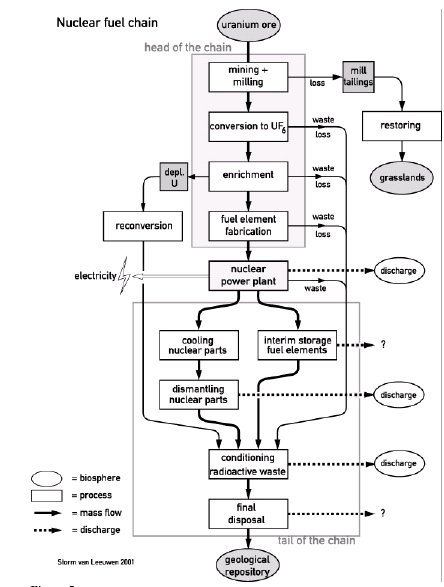
The Nuclear Fuel Chain. Source: [5]
Uranium Extraction
Yellowcake, or ammonium diuranate, is a uranium ore that exists naturally on earth. By weight, it is made up of 70 to 80 percent uranium oxide (U3O8).
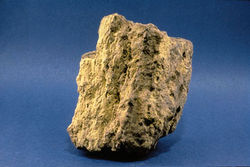
Uranate is another naturally occurring uranium ore. A lot of ore must be mined to extract U-235. For instance, at the Olympic Dam where ore is found with a uranium percentage of 0,05%, 2000 kilo grammes only contains one kilo gramme of this uranium isotope.[6]
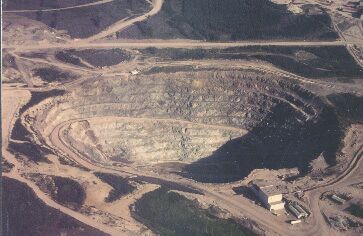
Uranium Mine Rabbit Lake
Whereas there are more than 4000 oil fields in the world, there are only a handful of uranium mines.
At this time, more than 73% of uranium originates from only ten mines. The table below gives an overview of the ten largest mines.
| Mine | Country | Stock (tU) * | Uranium grade ** | Production 2005 (tU) | Percentage World Production |
|---|---|---|---|---|---|
| McArthur River | Canada | 75.118 | 20,7% | 7.200 | 17,3% |
| Ranger | Australia | 22.073 | 0,165% | 5.006 | 12,0% |
| Olympic Dam | Australia | 58.512 | 0,051% | 3.688 | 8,9% |
| Rossing | Namibia | 4.255 | 0.029% | 3.147 | 7,6% |
| krazbokamensk | Russia | – | – | 3.000 | 7,5% |
| Rabbit Lake | Canada | 1.192 | 0,68% | 2.316 | 5,5% |
| McClean Lake | Canada | 4.912 | 0.68% | 2.112 | 5,1% |
| Akouta | Niger | 7.909 | 0.46% | 1.778 | 4,3% |
| Arlit | Niger | 16.716 | 0,3% | 1.315 | 3,2% |
| Beverley | Australia | 17.800 | 0,15% | 825 | 2,0% |
| Top 10 totaal | 30.387 | 73,1% | |||
* Sum of stored and proven reserves of uranium ore.
** Percentage is the weighed average of stored and proven reserves of uranium ore.
Large amounts of radioactive and acidic mud is left behind at the mine in most cases. For instance: the Olympic Dam mine in Australia now uses 15.9 million gallons of water daily – managing the acidic mud and radioactive waste that results is a huge environmental problem. [9]
In the eighties, the waste of some mines was simply dumped in nature. It is not clear what is happening to that waste currently.
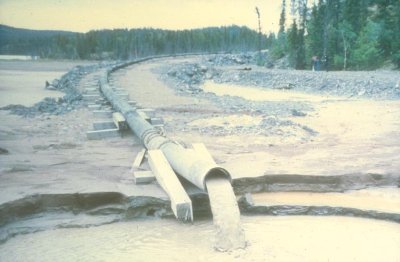
In the eighties millions of tons of mostly radioactive liquid and illiquid waste was dumped in Fookes Lake from the Beaverlodge uranium mine. Source: [18]
Conversion to UF6
Before uranium can be enriched it must first be converted into gas. Uranium hexafluoride (UF6) is the only suitable chemical composition because it has a high vapor pressure at room temperature.
Uranium hexafluoride is made by binding uranium to fluorine. This bond is converted to a gas at room temperature by lowering the pressure.
The chemical process involved in the production of UF6 is called conversion. [17]
Enrichment
Enriched uranium is uranium contains more U-235 isotope than it has in its natural state. It is used in nuclear energy and nuclear weapons.
The uranium found in nature consists mostly of U-238, a small fraction of U-235 and traces of U-234. Only U-235 is fissionable. Natural uranium has only an average of 0.7% U-235. To keep a chain reaction going a higher percentage of U-235 is required. Most nuclear reactors need uranium with at least three percent uranium-235. The process of attaining a higher percentage is referred to as enrichment.
Two methods are used to enrich uranium currently. The process exploits the fact that U-235 is lighter than U-238. The U-235 content can be raised using gas centrifuges or with gas diffusion.[10]
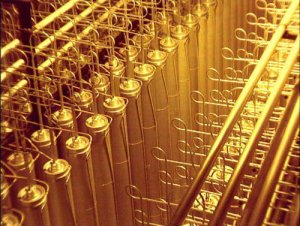
A row of centrifuges at the Urenco Factory
Making the Fuel Rods
The fuel for the power plant can then be made following the enrichment process. UF6 is converted into uranium oxide (UO2). Ceramic pellets are the most common form of reactor fuel. These are made from compressed uranium oxide, which is derived from a sintering (baking) process at more than 1400 degrees centigrade. The pellets are then put in metal canisters and thus form fuel rods which are arranged as fission packages for use in a reactor.[17]
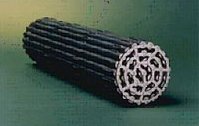
The Fuel Rods. Source [19]
Nuclear plant
The fuelrods with enriched uranium are used in the nuclear plant for the process of nuclear fission.
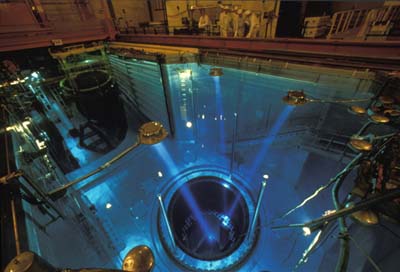
The uranium fuel rods are placed in the nuclear plant. Credits: Yann Arthus-Bertrand/Impact Photos
A tremendous amount of heat is generated when uranium is split. This fission process takes place in the core reactor of the plant. Water is heated into steam by the heat released through nuclear fission. The steam powers a turbine which drives a generator. This generator in turn supplies electricity to the electricity grid.[2]
The World’s Nuclear plants
At this moment, there are 442 nuclear plants. They together generate 2626 billion kWh annually. This is about 16% of the electricity generated in the world. A total of 65,478 tons of uranium are used by these plants.
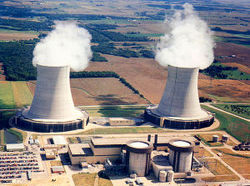
Two large cooling towers in the background with two nuclear reactors up front.[2]
At this time 38 new nuclear reactors are in the planning phase and there are proposals for an additional 115. [3]
Types of Nuclear Plants
Many different nuclear plant types exist. Below is an overview of nuclear power types now in use
| Reactor type | Main Countries | Number | GWe | Fuel | Coolant | Moderator |
|---|---|---|---|---|---|---|
| Pressurised Water Reactor (PWR) | US, France, Japan, Russia | 265 | 251.6 | enriched UO2 | water | water |
| Boiling Water Reactor (BWR) | US, Japan, Sweden | 94 | 86.4 | enriched UO2 | water | water |
| Gas-cooled Reactor (Magnox & AGR) | UK | 18 | 10.8 | natural U (metal), enriched UO2 |
CO2 | graphite |
| Pressurised Heavy Water Reactor ‘CANDU’ (PHWR) | Canada | 44 | 24.3 | natural UO2 | heavy water | heavy water |
| Light Water Graphite Reactor (RBMK) | Russia | 12 | 12.3 | enriched UO2 | water | graphite |
| Fast Neutron Reactor (FBR) | Japan, France, Russia | 2 | 1.0 | PuO2 end UO2 | liquid sodium | none |
| Other | Russia | 4 | 0.05 | enriched UO2 | water | graphite |
| TOTAL | 439 | 386.5 | ||||
Bron: [4]
Temporary Storage
The core reactor is halted following its operation cycle to replace the fuel rods. The consumed fuel rods are highly radioactive and have been inside the reactor for an average of three to six years. These rods are then placed in a so-called spent fuel pool. The ruel rods must first cool down in these water basins. Water serves as coolant and as a cover for the highly radioactive radiation. This process takes ten to twenty years.[20][21].
Decommissioning
The nuclear plant must also be decommissioning in the final phase of its operation. This includes all organizational, administrative and technical activities required in closing down the plant and returning it to the green field situation.
The typical operational lifetime of a nuclear plant is considered to be 40 years. In rare cases the lifetime can be extended beyond the initial 40 years by 20 years at the most. However, the lifetime tends to be shorter due to economic, political and safety considerations. The average age of the 107 nuclear reactors shut down up to 2004 was 21 years. [12]
The costs of decommissioning a nuclear plant depend on the type of plant. The costs vary from $200/kWe to $2700/kWe.
Here is an overview of the costs associated with shutting down the various nuclear plants still in operation.
| Calculation decommissioning costs existing nuclear plants | ||||
|---|---|---|---|---|
| Type | Cost per kW (Average) | Plant | Power (MW) | Cost ($) |
| PWR | $350 | Daya Bay 1 (China) | 984 | 344 million |
| VVER | $330 | Balakovo (Rusland) | 950 | 313 million |
| BWR | $425 | Shika 2 (Japan) | 1304 | 554 million |
| CANDU | $350 | Bruce Power (Canada) | 820 | 287 million |
| Gas-cooled | $2600 | Wylfa Magnox (UK) | 980 | 2,5 billion |
The price of uranium
The demand for uranium is currently larger than the quantity being mined. This shortage is currently filled by recycling uranium derived from the dismantling of nuclear weapens, primarily in Russia. Once all these weapons are recycled, analysts expect that despite higher production from new mines, a shortage of 22 million pounds will still exist in 2010. The current shortage is 25 million pounds. [11]
he price of uranium will rise substantially because of rising demand for uranium due to the construction of new nuclear plants.
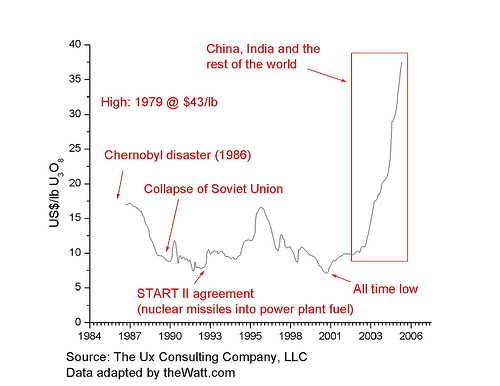
The nominal price of uranium
Net Energy Output
Jan Willem Storm van Leeuwen and Philip Smith published very thorough research [5] of the net energy output that is actually produced if the entire nuclear fuel chain is taken into the calculations. The result of their calculations is shown in the graph below. The graph illustrates the energy cost and return of a nuclear plant. The sections of the lines in the white portion of the graph are the sections that return net energy.
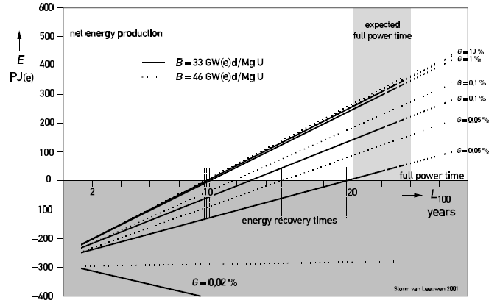
Nuclear plant net energy production. Click on the graph for details. Source: [5]
The graph shows that even with the richest uranium ore available, it takes 10 years before a nuclear plant starts to produce more energy than it cost to build and run it up to that point. For uranium ore with a lower percentage of uranium the situation is worse still:
A nuclear plant no longer produces net energy for uranium ore with a uranium content of 0.05% or lower. The amount of energy required to run the plant is then greater than the energy that is produced.
CO2 Emissions
The nuclear energy discussion usually involves the assumption that it is a good solution because no CO2 is emitted. However, if you take the entire nuclear cycle into consideration a nuclear plant produces a significant amount of CO2. The quantity of CO2 production depends greatly on how rich the source of uranium is. The lower the percentage of uranium in the ore, the carbon dioxide emission you get.
The graph below illustrates the carbon dioxide emission of a nuclear plant as a percentage of that of a gas-fired plant against the grade of uranium in the uranium ore mined
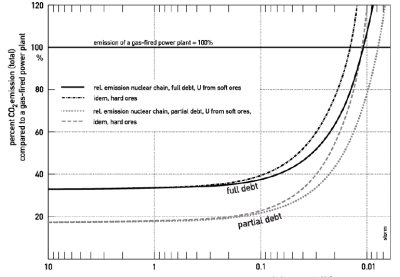
CO2 produced by nuclear power plant.Click on the graph for details. Source:[5]
The most favourable case in which uranium ore contains a very high uranium content the nuclear plant produces 33% of the volume produced by a gas plant, or 133 grams CO2 / KWh.
That means that a 1000 MW PWR nuclear plant producing at a capacity of 90% (Cummins, 2004) produces 7.88 TWH of power and more than a million tonnes of CO2.
If lower grades of uranium ore the carbon dioxide production increases accordingly.
If uranium ore contains 0.013% of uranium or less, the carbon dioxide production actually becomes greater than a gas plant, in other words, more than 3.15 million tonnes of carbon dioxide per year.
Longer term
Mines containing relatively high quality uranium ore are going to become fewer and fewer in the not too distant future. The average quality of ore being mined is almost certainly going to decrease. More and more mines with a relatively low percentage of uranium are going to enter production.
The result is that CO2 production in the nuclear chain is going to increase and that nuclear plants are going to produce an ever decreasing amount of net energy.
The rising demand for uranium and the stop-gap recycling of nuclear weapons will eventually exacerbate the existing shortage and drive up the price of uranium further.
Safety (on paper)
A controlled form of nuclear fission is taking place continuously within a nuclear plant. This can take place thanks to continuous cooling and the use of a moderator. The moderator ensures that the neutrons that are released during nuclear are caught and or restrained. If this does not happen a chain reaction begins that can no longer be stopped. The reactor core then becomes so hot that it melts and leading to what is known as a meltdown. If that happens nothing can stop the process. The reactor core is exposed and nuclear material can escape. When the extremely hot reactor core comes into contact with ground water, an extremely powerful chemical explosion can occur that causes radioactive material to be flung out. This is known as a worst case scenario.
When a calamity happens a nuclear plant can be shut down. However, because of the extremely hot reactor core this shut down takes about 6 days. In this period it is still extremely important that the plant stays cooled and the moderator works. On paper most nuclear plants seem very safe. They are equipped with many sensors and safety systems. In addition to the primary cooling system there is always a back up system to cool the plant.
Safety in practice
In practice a lot can go wrong that is not taken into consideration beforehand.
Here are a few examples of very serious nuclear incidents:
March 11, 2011 – Fukushima Nuclear Powerplant Japan
An earthquake of 9.0 on the Richter scale and the ensuing tsunami damage the electrical systems in the plants. This causes the cooling systems to shut down. The diesel generators that the company also has for back up power are also rendered inoperable by the tsunami since the plant lies on water. Extremely hot steam leads to the formation of hydrogen gas. The reactor core is now so hot that there is a partial meltdown. More info: Fukushima I Nuclear Power Plan
April 26, 1986 — INES Level 7 – Prypiat (Chernobyl), Ukraine (then USSR)
Electricity shuts down, explosion and complete meltdown.
March 28, 1979 — INES Level 5 – Middletown (Three Mile Island), Dauphin County, Pennsylvania, United States
Partial meltdown.
May 1967 – Dumfries and Galloway, Chapelcross Scotland, United Kingdom
Partial meltdown.
The complete list of major nuclear incidents can be found here. List of civilian nuclear accidents.
Conclusion
All things considered, nuclear energy doesn’t seem like THE best option for our energy problem.
To summarize the above, nuclear energy is associated with the following problems:
- A nuclear plant starts producing net energy after 10 years of operation. In the case of low grade uranium ore a nuclear power plant will not even supply any net energy.
- The construction of a plant takes about 10 years, the lifetime is 21 years on average and it takes another 150 years before it is completely dismantled. All of this and a plant effectively only produces energy for 10 years.
- The average nuclear plant produces more than one million tons of CO2.
- The price of uranium will rise significantly in the near future. This can only increase the cost price of nuclear energy further.
- A nuclear plant is safe on paper. However, practice shows that nuclear incidents cannot be avoided.



June 22nd, 2012 at 3:42 pm
Not all nuclear energy is the same! You should really have a look at LFTR (Liquid Fluoride Thorium Reactor) This really is the sollution for all our energy needs and does not have all the disadvantages of the classical ‘uranium’ reactors.
LFTR in 5 minutes: https://www.youtube.com/watch?src_vid=WWUeBSoEnRk&annotation_id=annotation_211321&v=P9M__yYbsZ4&feature=iv
June 23rd, 2012 at 2:19 am
@Anseeuw Karel,
On first site a Thorium reactor looks very promising. However, there are still large problems with running Thorium bases reactors. The problems include:
– The high cost of fuel fabrication due partly to the high radioactivity of U233 chemically separated from the irradiated thorium fuel.
– Separated U233 is always contaminated with traces of U232 (69 year half-life but whose daughter products such as thallium-208 are strong gamma emitters with very short half-lives). Although this confers proliferation resistance to the fuel cycle, it results in increased costs.
– The similar problems in recycling thorium itself due to highly radioactive Th-228 (an alpha emitter with two-year half life) present.
– Some concern over weapons proliferation risk of U233 (if it could be separated on its own), although many designs such as the Radkowsky Thorium Reactor address this concern. The technical problems in reprocessing solid fuels are not yet satisfactorily solved. However with some designs, in particular the molten salt reactor (MSR), these problems are likely to largely disappear.
– Much development work is still required, before the thorium fuel cycle can be commercialized, and the effort required seems unlikely while (or where) abundant uranium is available. In this respect, recent international moves to bring India into the ambit of international trade might result in the country ceasing to persist with the thorium cycle, as it now has ready access to traded uranium and conventional reactor designs.
More in-depth information can be found on:
http://europe.theoildrum.com/node/5929
June 23rd, 2012 at 2:25 am
Fast reactors (breeders) like Thorium reactors have three more areas of concern:
• Fast reactors are known for their worrying safety record. For example, it might be true that serious incidents, like the one that happened with the Chernobyl graphite moderated reactor, cannot happen with modern PWR’s. However, only very few nuclear experts would agree to such a statement for sodium cooled FBR’s.
• FBR’s are known for their huge construction costs relative to PWR’s, and it might be tempting to compare some of the past FBR’s to a monetary “black hole.” An equivalent of 3.5 billion Euros has been invested in the construction of the SNR-300 in Germany. Because of safety concerns related to sodium leaks and other problems, this small FBR has never started operation. This amount of money corresponds to the price tag for a five times more powerful modern PWR reactor.
• A third problem is related to the FBR requirements to have a large inventory of high purity fissile material. The amount of fissile material listed in Table 3 should be compared to the few tens of kgs required for a Pu239 bomb. This problem makes even small experimental FBR reactors highly sensitive to the proliferation problem.
June 23rd, 2012 at 2:56 pm
“Much development work is still required, before the thorium fuel cycle can be commercialized, and the effort required seems unlikely while (or where) abundant uranium is available. In this respect, recent international moves to bring India into the ambit of international trade might result in the country ceasing to persist with the thorium cycle, as it now has ready access to traded uranium and conventional reactor designs.”
Right at this moment The People’s Republic of China has initiated a research and development project in thorium molten-salt reactor technology. Also Norway has plans to build one. In Belgium there was also a proposal to build one… India is seen internationally as a pioneer in MSR technology. Also the fact that Thorium is 3 times more available than uranium is a stimulating factor.
“• Fast reactors are known for their worrying safety record. For example, it might be true that serious incidents, like the one that happened with the Chernobyl graphite moderated reactor, cannot happen with modern PWR’s. However, only very few nuclear experts would agree to such a statement for sodium cooled FBR’s.”
A LFTR does not have to be cooled with sodium (with is actually a stupid idea and has never been done before). A second not radioactive molten salt cycle captures the heat and gives it to a classic turbine.
A LFTR is indead a fast breeder, but not all fast breerders are cooled with sodium.
“FBR’s are known for their huge construction costs relative to PWR’s, and it might be tempting to compare some of the past FBR’s to a monetary “black hole.” An equivalent of 3.5 billion Euros has been invested in the construction of the SNR-300 in Germany. Because of safety concerns related to sodium leaks and other problems, this small FBR has never started operation. This amount of money corresponds to the price tag for a five times more powerful modern PWR reactor.”
Again a LFTR is indead a fast breeder, but not all FBRS are expensive and huge. At this moment designs are beeing made for small inexpensive LFTR’s for te us army. An LFTR has the advantage it can be scaled very easy.
February 15th, 2019 at 2:36 pm
Russia and US etc. are re-starting there destructive nucleair weapon-program which means optional suicide for humanity; sign the petition against this on http://www.Raelcanada.org on topic ‘Safe humanity’. This means nucleair power can be used for destructive and for constructive purposes. For example when the expansion of the weapon program stops, than the money which is left can be invested in food, shelter, education for refugees, warvictims and 3th world; so mother earth than can be cured and be in balance again.